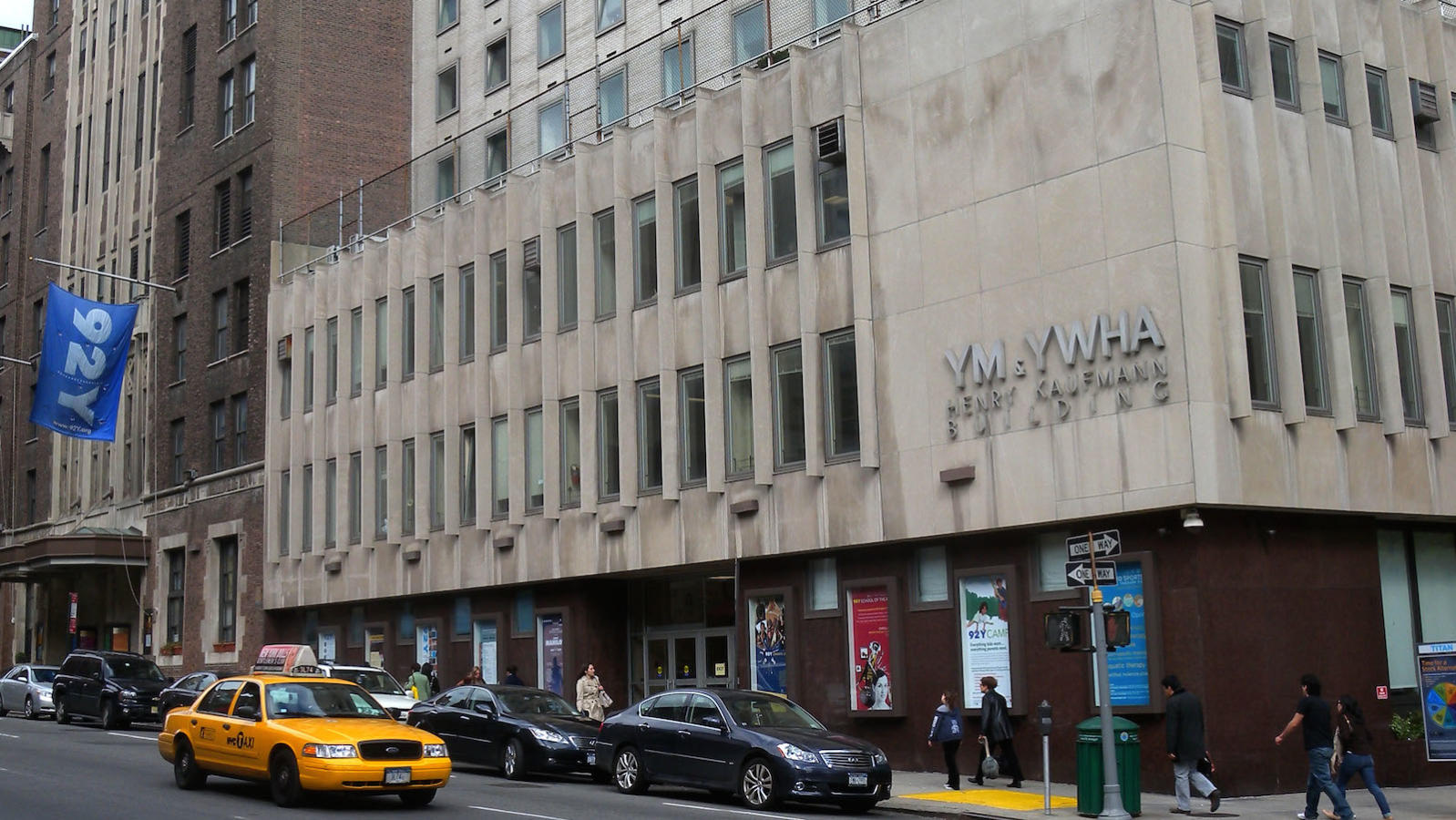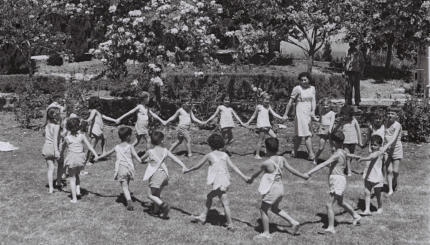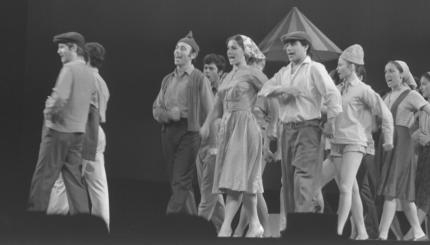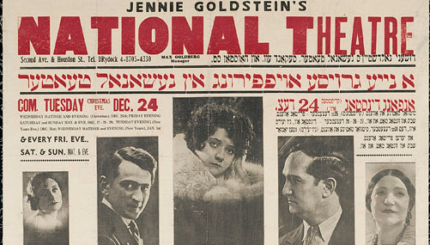If the intersection with contemporary art was to help to define the nature of American Jewry, the reverse was also true. William Kolodney, educational director of New York’s 92 Street YM-YWHA from 1934 to 1969, along with the Y’s audiences, teachers, and students, helped to broaden modern dance to embrace diversity in terms of ethnicity, race, age, experience, and stylistic experimentation.
This was achieved through the Y’s long sponsorship of young European-trained dancers, dancers of different ethnic origins–Hispanic, African American, and most particularly, Jewish — and dancers who largely operated outside New York City.
The role played by the Y in the dance world, however, was far from straightforward, reflecting the frequently liminal status of Jews as both insiders and outsiders in American culture. Pulling the Y to the center of what has since come to be viewed as the mainstream modern dance world–associated with critic John Martin and dancers like Martha Graham and Doris Humphrey–was the Y’s close and long-standing relations with its key players.
Conservative Tendencies
At the beginning of his tenure at the Y, Kolodney recognized his limited knowledge about dance. His desire to present the best and most powerful in the field led him to search out Martin, followed by the composer Louis Horst (who was closely connected to Martha Graham) and Doris Humphrey as advisors. As is well known, these individuals were central creators and propagators of early modern dance, active in many aspects of its development.

Help us keep Jewish knowledge accessible to millions of people around the world.
Your donation to My Jewish Learning fuels endless journeys of Jewish discovery. With your help, My Jewish Learning can continue to provide nonstop opportunities for learning, connection and growth.
Martin and Horst in particular were conservative forces at the Y and elsewhere, pushing for the establishment of general principles and the creation of standards for modern dance and championing a limited number of choreographers as reaching those standards, notably Graham, Humphrey, and Weidman.
As third- and fourth-generation Americans, these dancers fit well with Martin’s framing of modern dance as pure, non-ethnic, and generically American in a way that masked difference while implicitly favoring white Anglo-Saxon choreographers. The subtly racist aspects of Martin’s conceptualization were most evident in his problematic distinction between modern and so-called ethnic dance and in his reviews of black dancers, as revealed in recent studies of this period.
On the Fringes
A number of factors pushed the Y to the margins of general dance activity. The Y’s location outside the downtown theater district meant that it did not receive the same recognition as a Broadway venue, and most of its dance performances were not reviewed in the daily newspapers, a severe limitation for many dancers. The Y’s perceived status as a sectarian, recreational institution also made it suspect to secondary consideration, being viewed by some as too low-key and, for those aware of its origins, “too Jewish.”
The opinion was hinted at by the booking agent Frances Hawkins, who angrily wrote to Kolodney concerning the loss of money on performances by Lincoln Kirstein’s newly established Ballet Caravan after it appeared at the Y in the late 1930s. She claimed, “I think that in a downtown theatre the same size as the Kaufmann Theatre, I could schedule even two performances for the Caravan and sell out both of them. The Kaufmann Auditorium is inaccessible and it is not associated in peoples’ minds with professional dance performances.” Hawkins further attacked the Y’s policy of closing for the Jewish Sabbath.
Most significantly, the Y’s particular way of conceiving of Jewishness, as a synthesis of the “general” and “particular” in a manner that retained the integrity of people’s differences, led to the support of individuals and policies that fostered programming not quite in accord with the interests of Martin and his followers.
Diverse Dancers
The Jewish dancers, in particular, who were featured on the Y’s stage were a constant challenge to the potential ethnocentrism and racism of the dominant discourse of modern dance. Sophie Maslow, for instance, represented a generation of Jewish dancers from poor Russian-Jewish backgrounds, whose leftist orientation led them to embrace the democratic promise of the modern dance movement.
She not only assumed the acceptance of Jewish dancers as valid artists but also hired black dancers to perform in her pieces when it was a far from common occurrence. The New York premiere of The Village I Knew, for instance, which focused on Jewish experiences in a in tsarist Russia, took place at the Y in 1951 and had two black dancers in the cast–Ronne Aul and Donald McKayle.
Others from similar backgrounds, especially Anna Sokolow, enjoyed long associations with the Y and similarly used black dancers over the years, including Alvin Ailey. Sokolow’s early revolutionary Dance Unit performed at the Y in the 1930s, and she later premiered a number of major works on its stages, including those that focused on the horrors of oppression, as with Dreams in 1961.
Dance & Politics
The important role played by working-class dancers in the making of American modern dance has recently gained recognition with the publication of Ellen Graff’s Stepping Left: Dance and Politics in New York City, 1928-1942 (1997) and Mark Franko’s Dancing Modernism/Performing Politics (1995). Both writers have persuasively shown that a large number of dancers with left-wing leanings existed in the late 1920s and 1930s, and that these dancers challenged the dominant discourse promulgated by Martin (which emphasized the abstract, personal nature of modern dance) by linking dance to social and political causes.
Graff also notes the fact that “the single most important distinction between choreographers allied with bourgeois dance and those allied with workers’ dance” was the Eastern European Jewish origin of dancers on the left.
It was the daughters of poor Jewish immigrants who led the challenge; and in their attempt to make a place for themselves in America they used working-class ties to bridge racial, religious, and gender differences and fought to enlarge the definition of modern dance to make room for themselves and others (especially African Americans) who similarly lacked a place in standard American mythology.
Significantly, many of these women simultaneously formed the backbone of the early schools and companies of Graham, Humphrey/Weidman, and Holm, illustrating the way in which Jews shifted back and forth between the roles of insider and outsider in the dance world.
An Educated Audience
The middle-class and affluent Jews, who made up the main membership of the Y (as staff, students, and audience members), were equally important in shaping the evolution of dance throughout the period owing to their patronage of the form. Often less stridently political and more directly engaged in a process of smooth integration into existing American life than were their working-class brethren, these Jews were nonetheless committed to nondiscriminatory practices and to making contemporary dance as inclusive as possible.
Kolodney’s programming vision, for instance, made the Y for many years the main stage for African Americans to present their work, from Katherine Dunham in the late 1930s to the historical debut performances by Alvin Ailey in the late 1950s. This aspect of the Y’s history has gained increasing visibility, largely through recent attempts to document African American contributions to American dance, such as John O. Perpener III’s “Seminal Years of Black Concert Dance” (1992) and Jennifer Dunning’s biography, Alvin Ailey: A Life in Dance (1996).
Moreover, Jewish patronage at the Y played a central role in developing an educated audience for modern dance in New York that helped the genre evolve. The extensive program of classes and lectures, such as the critic Walter Terry’s Dance Lab, which ran from 1947 to 1963, resulted in the creation of a highly informed Jewish public that was well versed in a broad range of movement styles.
A large number of patrons of the Y repeatedly showed up at the Sunday afternoon recitals until they became articulate in interpreting and assessing work by radically different artists. As a reviewer of one Y dance recital in 1941 observed, “It was an audience equipped with the necessary knowledge of technique, familiar with the interpretive method, and thus able to analyze and discuss the performance intelligibly and intelligently.”
Some of these individuals became lifelong supporters of dance, sending their children to take classes in the future. Others were stimulated to become performers themselves, adding to a growing number of Jewish artists and intellectuals working in the city.
Modernism and Postmodernism
Between the audiences and dancers, policies and presentments, studying the history of dance at the Y in many ways allows us to rethink our conception of both the modern and the subsequent era of postmodern dance, which began in the 1960s and has continued through the 1990s.
While standard histories of American dance see a radical divide between the two movements, with postmodern dance bursting onto the scene with the work of the Judson Dance Theater in the early 1960s, it may be that there is a greater connection than previously thought.
Today, one of the most visible dimensions of postmodern culture is the movement toward multiculturalism, which challenges the priority of a monolithic identity in American history, highlighting racial as well as ethnic diversity and claiming public resources on behalf of these groups. The Y’s long patronage of Jewish, African American, and out-of-town dancers, among others, foreshadowed many of the current effects and questions of multiculturalism in the postmodern dance world in terms of both policy and style.
The choreography of young, lesser-known artists of all kinds appearing at the Y was often innovative, involving a combining of different movement traditions. Analyzing their legacy can help us to better understand current choreographers’ fascination with stylistic fusion as well as lead to a greater awareness of the continuity of the democratic tradition in American dance.
Reprinted with permission from Converging Movements: Modern Dance and Jewish Culture at the 92nd Street Y (Wesleyan University Press).



